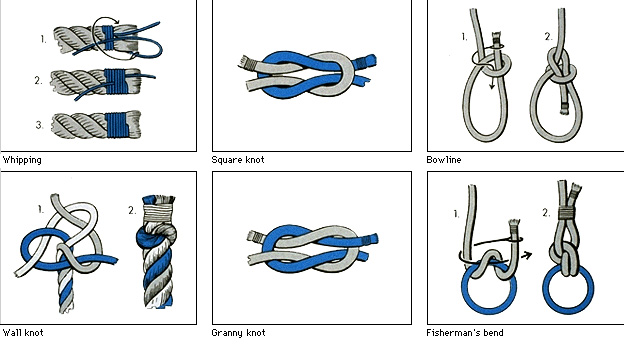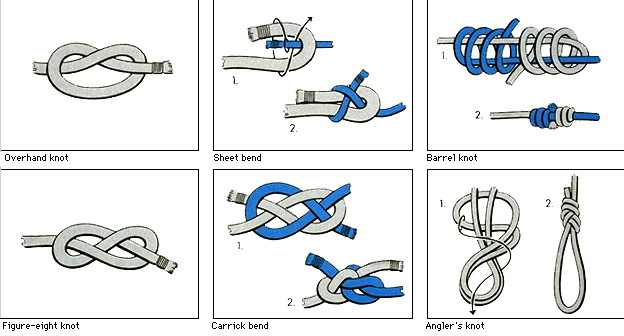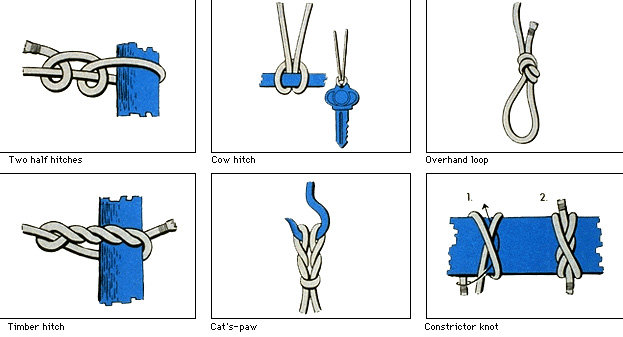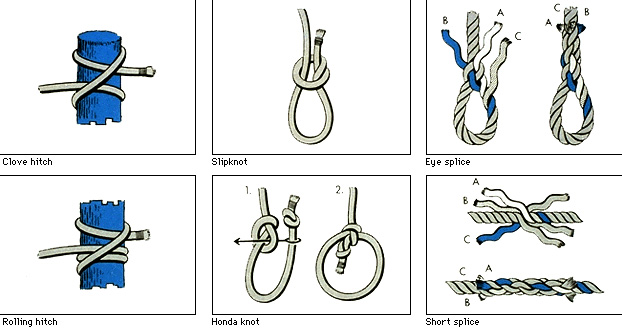Knots, hitches, and splices are methods used to tie ropes or to fasten them together. Most persons call any method of tying rope a knot. But experts generally recognize a difference between knots, hitches, and splices. A knot is any fastening made with cords or ropes. A hitch is used to tie a rope to a ring, spar, post, or other object. A splice permanently joins the ends of two ropes, or forms a single rope into a permanent loop. A fourth type of knot, the bend, is used to tie the ends of two ropes together.

A rope with a knot in it is weaker than an unknotted rope. For example, a square knot weakens a rope by 50 per cent, and a bowline weakens a rope by 40 per cent. In general, hitches weaken a rope less than knots and bends do, and splices weaken a rope even less than hitches do.
Uses of knots
In spite of the development of wire rope and mechanical fastenings, knots are still important to people in many occupations. The ability to tie knots has always been one of the chief skills required of sailors, and remains important on ships and boats. Sailors use knots to fasten ropes on objects to be lifted on or off vessels. Sailboat owners must master the skill of tying knots in order to adjust the rigging—lines attached to the sails, booms, and masts. See Sailing (The parts of a sailboat).
Sports enthusiasts use knots to set up tents, to prepare fishing tackle, to build traps, and to do hundreds of other jobs. Surgeons must tie the tiny knots in sutures (threads) used to close incisions.
Knots are widely used on farms. For example, farmers have to be able to tie knots in the rope used to make halters for animals. Knots are also used to hitch horses, cows, and other animals to posts. Farmers often have to rig blocks and tackles to lift hay or other products into barns (see Block and tackle).
Other persons who make wide use of knots and rope include explorers, mountain climbers, builders, and weavers. Members of the Boy Scouts and Girl Scouts learn the art of tying knots because of their importance in camping and hiking. Learning how to tie many different types of knots can also be a hobby. Many persons make knot boards that permanently display various kinds of knots.
Tying knots
The language of knots
was developed to name the various parts of a rope and the simple shapes into which they can be formed. The end of a rope is the part with which knots are tied. The rest of the rope is called the standing part.

The simple shapes that can be made with rope form the basis for all knots. A person forms a bight by placing the end of the rope alongside the standing part to form a loop. In an overhand loop, the end of the rope is crossed over the standing part. An underhand loop is the opposite of an overhand loop. It is formed by placing the end of the rope beneath the standing part. An overhand knot is a loop through which an end has been passed. This knot is used on the end of a rope as a stopper to keep it from running through small openings.
Preparing rope for knots.
You can use most rope for knot tying without preparing it. However, most experts do two things to a rope before putting it to use. Most new rope is stiff, so experts usually work the rope, or stretch, twist, and pull it to take the stiffness out.

The most important thing that has to be done to a new rope is whipping. This means tying the ends so they do not unravel. There are several ways of whipping a rope. In one simple method, form a piece of light yarn into a loop and place the loop along the rope near the end to be whipped. Then tightly wind the yarn around the loop and rope to bind them together. Keep winding until the length of the whipping equals the diameter of the rope, but leave a small part of the yarn loop exposed. When the winding is completed, draw the short end of the twine through the loop, and pull both ends until the loop is drawn beneath the winding. Then trim the ends of the yarn.
Sailors often use a more difficult method to whip rope. They call it the palm and needle method because it involves the use of a needle similar to that used for sewing, and a leather glove, or palm. The palm is used to force the needle through the rope. The illustrations with this article show still another method of whipping a rope.
Useful knots.
Choosing the right knot is an important part of working with rope. Most knots have been developed to meet some particular need. Some of the most useful knots are described below and illustrated with this article. 
The square knot
is probably the best known and most widely used knot. It serves to join the ends of two ropes, and has the advantage of strength and ease of tying and untying. It slips or jams only if pulled around a corner. Under such conditions, a carrick bend or a splice must be used. People use square knots to tie packages and to fasten towing lines. Most people use a variation of the square knot to tie their shoes. An improperly tied square knot is called a granny knot. A granny knot may come loose under pressure and should not be used.
The bowline
has a wide range of uses. It ranks as one of the basic knots. At the end of a rope, the bowline forms a strong loop that will not slip or jam if properly tied. Its uses include fastening animals to objects and forming seats from which people may be suspended while painting, cleaning, or doing other jobs.
Two half hitches
are used to fasten a rope temporarily to a post, hook, or ring. Other useful hitches include the clove hitch for fastening rope to smooth timbers, and the timber hitch for dragging logs.
History
Knots are one of the oldest inventions. People used them to tie arrowheads to their shafts, and to tie bowstrings to bows. Other early uses of knots included making clothes and fishing nets, and binding wood together to make a hut or other shelter. The ancient Inca Indians of Peru used knots to keep records of sums and figures.
One of the most famous knots is the Gordian knot, mentioned in Greek mythology. This knot was so intricate that legend said that the man who could untie it would rule Asia.
